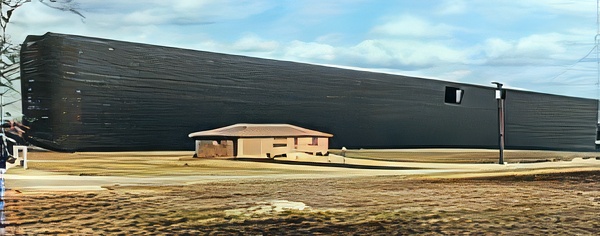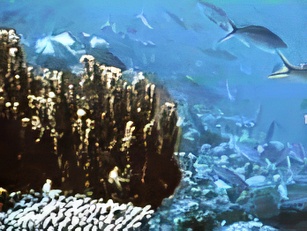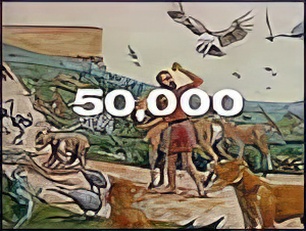Could Noah’s Ark really hold all the animals God sent?

A growing number of scientists believe that geological evidence indicates our world has undergone a catastrophic flood. This is causing them to question whether or not the biblical account of Noah’s ark could be true. Many people are rereading the Biblical description of the Ark to ascertain the feasibility of such a vessel to fulfill its designated purpose in light of present day knowledge of both zoology and our present day knowledge of shipbuilding.
How big was Noah’s Ark?

“And God said unto Noah… Make thee an ark of gopher wood; rooms shalt though make in the ark, and thou shalt pitch it within and without with pitch. And this is the fashion which thou shalt make it of… the length of the ark shall be three hundred cubits, the breadth of it fifty cubits, and the height of it thirty cubits. A window shalt thou make in the ark, and in a cubit shalt thou finish it above; and the door of the ark shalt thou set in the side therof; with lower, second, and third stories shalt thou make it.” (Gen. 6:14-16)

Most Hebrew scholars believe the cubit to have been no less than 18 inches long [45.72 centimeters]. This means that the Ark would have been at least 450 feet long [137.16 meters], 75 feet wide [22.86 meters] and 45 feet high [13.716000000000001 meters].
Noah’s Ark was said to have been the largest sea-going vessel ever built until the late nineteenth century when giant metal ships were first constructed.
Its length to width ratio of 6:1 provided excellent stability on the high seas. In fact, modern shipbuilders say it would have been almost impossible to turn over. In every way, it was admirably suited for riding out the tremendous storms in the year of the flood.
These dimensions are especially interesting when compared to those given in the mythical, Babylonian account of the Ark. Here the ark is described as a perfect cube, extending 120 cubits in all directions and with nine decks. Such a vessel would spin slowly round and round in the water and from the standpoint of stability, would be a disaster.
Was the ark big enough to hold the number of animals required?
The total available floor space on the Ark would have been over 100,000 square feet, which would be more floor space than in 20 standard-sized basketball courts.


The total cubic volume would have been 1,518,000 cubic feet [462,686.4 cubic meters] — that would be equal to the capacity of 569 modern railroad stock cars.
Now comes the question, how many land dwelling air breathing animals would have had to be taken aboard the ark to survive the flood?
According to Ernest Mayr, America’s leading taxonomist (deceased), there are over 1 million species of animals in the world.
However, the vast majority of these are capable of surviving in water and would not need to be brought aboard the ark. Noah need make no provision for the 21,000 species of fish or the 1,700 tunicates (marine chordates like sea squirts) found throughout the seas of the world, or the 600 echinoderms including star fish and sea urchins, or the 107,000 mollusks such as mussels, clams and oysters, or the 10,000 coelenterates like corals and sea anemones, jelly fish and hydroids or the 5,000 species of sponges, or the 30,000 protozoans, the microscopic single-celled creatures.
In addition, some of the mammals are aquatic. For example, the whales, seals and porpoises. The amphibians need not all have been included, nor all the reptiles, such as sea turtles, and alligators. Moreover, a large number of the arthropods numbering 838,000 species, such as lobsters, shrimp, crabs and water fleas and barnacles are marine creatures. And the insect species among arthropoda are usually very small. Also, many of the 35,000 species of worms as well as many of the insects could have survived outside the Ark.
How many animals needed to be brought aboard?
Doctors Morris and Whitcomb in their classic book,The Genesis Flood state that no more than 35,000 individual animals needed to go on the ark. In his well documented book, Noah’s Ark: A Feasibility Study, John Woodmorappe suggests that far fewer animals would have been transported upon the ark. By pointing out that the word “specie” is not equivalent to the “created kinds” of the Genesis account, Woodmorappe credibly demonstrates that as few as 2,000 animals may have been required on the ark. To pad this number for error, he continues his study by showing that the ark could easily accommodate 16,000 animals.

But, let’s be generous and add on a reasonable number to include extinct animals. Then add on some more to satisfy even the most skeptical. Let’s assume 50,000 animals, far more animals than required, were on board the ark, and these need not have been the largest or even adult specimens.
Remember there are really only a few very large animals, such as the dinosaur or the elephant, and these could be represented by young ones.
Assuming the average animal to be about the size of a sheep and using a railroad car for comparison, we note that the average double-deck stock car can accommodate 240 sheep.
Thus, three trains hauling 69 cars each would have ample space to carry the 50,000 animals, filling only 37% of the ark. This would leave an additional 361 cars or enough to make 5 trains of 72 cars each to carry all of the food and baggage plus Noah’s family of 8 people.
The Ark had plenty of space.
The bigger problem would have been the construction of the Ark. But the Bible indicates that Noah did this under Divine guidance, and there is no reason to believe he did not hire additional workmen.
How were the animals gathered?
Another enormous problem some have posed is the gathering of specimens of each kind of air-breathing land animal and bringing them aboard the Ark. However, the Genesis account indicates that God gathered the animals and brought them to Noah inside the Ark two by two.
Some have suggested this may have involved the origin of animal migratory instincts or, at least, an intensification of it. We also know that most animals possess the ability to sense danger and to move to a place of safety.
How could Noah’s family take care of all those animals?

Once aboard, many have suggested that Noah’s problems really began, with only 8 people to feed and water, to provide fresh air and sanitation for the huge menagerie of animals for a total of 371 days. However, a number of scientists have suggested that the animals may have gone into a type of dormancy. It has been said that in nearly all groups of animals there is at least an indication of a latent ability to hibernate or aestivate. Perhaps these abilities were supernaturally intensified during this period. With their bodily functions reduced to a minimum, the burden of their care would have been greatly lightened.
Conclusion
It is evident, when all the facts are examined that there is no scientific evidence that the biblical account of Noah’s ark is a myth or fable. The facts support the view that Noah’s ark was large enough to carry the number of animals required to repopulate the Earth after the flood and that Noah and his family were capable of caring for the animals during their time on the Ark.
The flood of Noah’s day was a universal judgment of sin. God destroyed the world that existed at that time because of their wickedness.
When we look at nature, with its testimonies to the worldwide Flood, we are viewing a reminder that God does judge sin. It is also a reminder that God will save those who have faith in Him from the Final Judgment.
In the meantime, God promised that He would never again destroy the world with water, but that a future judgment would take place. Jesus Christ came into the world to die for our sins and to restore man’s relationship with God, so that we need not fear His judgment.
Noah pleaded with the people of his day to repent and have faith in God. They would not listen, and the door to the ark was closed.
Now, Christ is calling unto the world to once again have faith in God. Will you answer His calling and be saved from future judgment? The decision is yours.
Authors: Stanley E. Taylor and Paul S. Taylor, adapted from their motion picture The World That Perished, produced and distributed by Films for Christ (Christian Answers Network).
Copyright © 1997, 1999, 2023, 2025, Films for Christ, All Rights Reserved—except as noted on attached “Usage and Copyright” page that grants ChristianAnswers.Net users generous rights for putting this page to work in their homes, personal witnessing, churches and schools.




 Has anyone really seen Noah’s Ark?
Has anyone really seen Noah’s Ark?